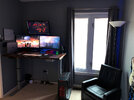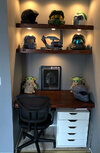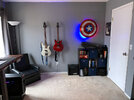Fallen
DTO, RCO & BCO
Division Staff
Midwest Regiment
405th Regiment Officer
Longsword
Community Staff
Stream Team
- Member DIN
- S922
I've been wanting to do a Carter build for several years now, but as part of that I'm working to get back in shape, so the bulk of that build hasn't started yet. Carter has that TacPad on his forearm, and it's always been in my mind that I wanted more than just a static image in place there. Since I have the time before I start on the armor parts of my build, I'm using this opportunity to start the process of making the TacPad something more. As some of you may know, I'm a mobile developer who does primarily iOS but also has experience developing for Android. I want to take that experience and develop a mobile app that I and others can use as a TacPad in the style of Reach with functionality.
I will warn you, that there will likely be some technical jargon in my posts. I'm a nerd, and I love all of the problem solving that comes with writing code and creating functional apps.
The Primary Goal
Build mobile apps for iOS and Android in the style of Reach that can be used to provide useful information throughout conventions.
Ultimately I want to make something that will track and display my health information throughout the day, give me reminders, and ideally be able to control various planned systems in my suit when I build it. I also want to make the app something that I can share with other members to set up and use for themselves with minimal effort.
MVP
First up I need to define what is MVP (Minimum Viable Product) for this project. My stretch goal has a lot of problems to solve and systems that I have never written code for, so I need to split things up into features and define a prioritized order to start getting things done. For this I've defined MVP as having the main UI based on references provided by TurboCharizard but with some kind of function rather than a static image. I've decided at this point to take what looks like 4 buttons on the left side and sync them up as a mini soundboard, and add some hard-coded information in what looks like a smaller info view within the greater interface.
The Technology
iOS: Swift, supporting iOS13+ 15.0+
Android: Kotlin, support Android 8+ (Oreo+) DEVELOPMENT ON HOLD
Hoping to be able to use some Kotlin Multiplatform to share some of my business logic across both iOS and Android.
Testing
TestFlight Invite
I'll be doing private testing that I'll open up to any members who want to be involved sometime after MVP. Feel free to PM me if interested.
Shout Outs
TurboCharizard for providing images to reference creating the base interface
RandomRanger for additional functionality ideas
Angus314 for testing early features and providing feedback and suggestions
I will warn you, that there will likely be some technical jargon in my posts. I'm a nerd, and I love all of the problem solving that comes with writing code and creating functional apps.
The Primary Goal
Build mobile apps for iOS and Android in the style of Reach that can be used to provide useful information throughout conventions.
Ultimately I want to make something that will track and display my health information throughout the day, give me reminders, and ideally be able to control various planned systems in my suit when I build it. I also want to make the app something that I can share with other members to set up and use for themselves with minimal effort.
MVP
First up I need to define what is MVP (Minimum Viable Product) for this project. My stretch goal has a lot of problems to solve and systems that I have never written code for, so I need to split things up into features and define a prioritized order to start getting things done. For this I've defined MVP as having the main UI based on references provided by TurboCharizard but with some kind of function rather than a static image. I've decided at this point to take what looks like 4 buttons on the left side and sync them up as a mini soundboard, and add some hard-coded information in what looks like a smaller info view within the greater interface.
The Technology
iOS: Swift, supporting iOS
Android: Kotlin, support Android 8+ (Oreo+) DEVELOPMENT ON HOLD
Testing
TestFlight Invite
Shout Outs
TurboCharizard for providing images to reference creating the base interface
RandomRanger for additional functionality ideas
Angus314 for testing early features and providing feedback and suggestions
Last edited:



